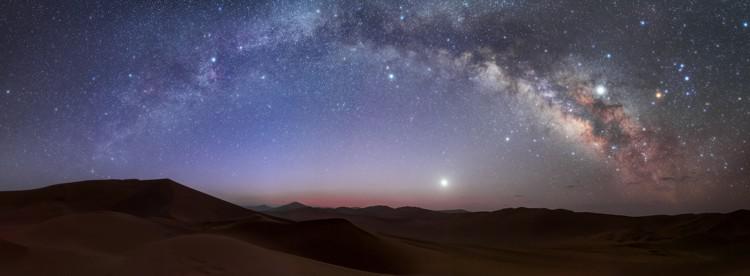This page describes an image Milky Way Arch over Lut Desert, Iran, by Amirreza Kamkar, Iran (Islamic Republic of)
Caption:
Second place in the 2021 IAU OAE Astrophotography Contest, category Wide star fields.
This panoramic dawn image shows the majestic band of the Milky Way – our home Galaxy – made up of a few hundred billion stars, among other structures, most of which are not detectable by our eyes, or in some cases even directly with telescopes. The appearance of the band is because the Milky Way is a disc-shaped galaxy, and we (Earth/Solar System) are situated within the disc.
Diverse cultures and traditions around the world each have their own name and cultural stories for the Milky Way. The dark regions visible in the Milky Way are large, dense, cool nebulae (clouds of dust and gas), which obscure the light from stars in the Milky Way. The Indigenous Australians associate stories with the dark patches of the Milky Way, one of the most prominent being the Emu in the Sky (called Tchingal in Wotjobaluk country). In and around the band of the Milky Way there are a vast range of star clusters, two familiar ones are M6 (Butterfly cluster) and M7 (Ptolemy’s cluster).
The bright point just above the horizon is the planet Venus (known to the Boorong people of Indigenous Australia as Chargee Gnowee, elder sister of the Sun). Within the band of the Milky Way the brightest point in the image is the planet Jupiter (called Ginabongbearp, the Sulphur-crested white cockatoo by the Boorong). The planet Saturn is the bright point between Venus and Jupiter (closer to Venus than Jupiter).
There are two constellations and one asterism that can be easily discerned in the image: Aquila, Scorpio (Maui’s Hook), and Teapot (asterism in Sagittarius). In this image, the center of the Milky Way at an approximate distance of 26,000 light years from Earth, is located roughly to the top right of the Teapot spout.
The bright red-orange point to the right of Jupiter is the red supergiant star Antares and is part of the constellation Scorpio (known as Maui’s Hook in Māori and Polynesian cultures). This variation in the colour of stars is the result of temperature of the stars (lower temperature stars are redder, higher temperatures stars are bluer).
Credit:
Amirreza Kamkar/IAU OAE
DOI: 10.5281/zenodo.5425799
Related glossary terms:
Dust Cloud
, Milky Way
Categories:
Milky Way and Interstellar Medium
, Naked Eye Astronomy
License: Creative Commons Attribution 4.0 International (CC BY 4.0) Creative Commons Attribution 4.0 International (CC BY 4.0) icons
The media file captions presented on the OAE website were written, translated and reviewed by a collective effort from the OAE, the OAE Centers and Nodes, the OAE National Astronomy Education Coordinators (NAECs) and other volunteers. You can find a full list of credits for our translation project here. All media file captions are released under a Creative Commons CC BY-4.0 license and should be credited to "IAU OAE". The media files themselves may have different licenses (see above) and should be credited as listed above under "credit".
Captions in Different Languages:
Caption: Secondo posto al concorso di astrofotografia IAU OAE 2021, categoria "Campi stellari estesi".
Questa immagine panoramica dell'alba mostra la maestosa fascia della Via Lattea - la Galassia in cui ci troviamo - composta da alcune centinaia di miliardi di stelle e da varie altre strutture, la maggior parte delle quali non possono essere percepite dall'occhio umano, e talvolta neanche direttamente dai telescopi. La Via Lattea assume l'aspetto di una fascia perché si tratta di una galassia a forma di disco, e noi (Terra e Sistema Solare) ci troviamo al suo interno.
Diverse culture e tradizioni in tutto il mondo hanno un proprio nome per la Via Lattea e i propri miti a riguardo. Le regioni scure visibili nella Via Lattea sono costituite da grandi, dense e fredde nebulose (nubi di polvere e gas), che oscurano la luce delle stelle della Galassia. Gli indigeni australiani associano diverse storie alle macchie scure della Via Lattea; una delle più importanti è quella dell'Emù nel cielo (chiamato Tchingal nella terra dei Wotjobaluk). All'interno e in prossimità della fascia della Via Lattea si trovano numerosi ammassi stellari, due dei quali sono molto conosciuti: M6 (l'Ammasso Farfalla) e M7 (l'Ammasso di Tolomeo).
Il punto luminoso appena sopra l'orizzonte è il pianeta Venere (conosciuto dalle popolazioni Boorong dell'Australia aborigena come Chargee Gnowee, sorella maggiore del Sole). Il punto più luminoso dell'immagine, all'interno della fascia della Via Lattea, è il pianeta Giove (chiamato Ginabongbearp, il cacatua bianco dalla cresta di zolfo, dai Boorong). Il pianeta Saturno è il punto luminoso situato tra Giove e Venere, leggermente più vicino a quest'ultimo.
Due costellazioni e un asterismo sono facilmente distinguibili nell'immagine: Aquila, Scorpione (Gancio di Maui) e Teiera (asterismo nel Sagittario). In questa immagine il centro della Via Lattea, la cui distanza dalla Terra è di circa 26.000 anni luce, si trova approssimativamente in alto a destra rispetto al beccuccio della Teiera.
Il punto luminoso rosso-arancio alla destra di Giove è la stella supergigante rossa Antares, che fa parte della costellazione dello Scorpione (nota come Gancio di Maui nella cultura Māori e in quelle polinesiane). La differenza di colore delle stelle è il risultato della loro temperatura superficiale (le stelle di bassa temperatura sono più rosse, quelle di alta temperatura sono più blu).
Credit: Amirreza Kamkar/IAU OAU
Related glossary terms: Nube di polvere , Via Lattea Caption translation status: Approved by a reviewer
Caption translators: Giuliana Giobbi, Emanuele Nardini
Caption reviewers: Rosa Valiante, Silvia Casu, Rodolfo Canestrari, Raffaella Ferretti









